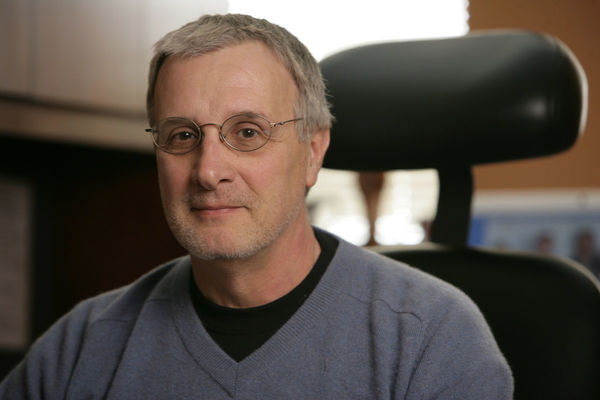
Trauma, or any kind of severe physical injury, continues to be today’s leading cause of death for people 46 and younger in the United States. In 2007, Dr. Scott Thomas and Dr. Mark Walsh of Memorial Hospital in South Bend were looking for a better way to treat trauma patients who arrived in the emergency room (ER) with excessive bleeding. Their search eventually led to a translational research collaboration with the W. M. Keck Center for Transgene Research at the University of Notre Dame and the development of a new method for treating trauma patients.
Upon arrival to an ER, about 25 to 35 percent of seriously injured trauma patients have excessive bleeding, or coagulopathy, without clotting. Traditionally, coagulopathy could be treated with fluid resuscitation, but Thomas, chief of trauma services for Beacon Health Systems, and Walsh, an ER physician, knew that a blood replacement product – like platelets, plasma, or cryoprecipitate – would be a better treatment option.
 Professor Francis J. Castellino
Professor Francis J. Castellino
However, each patient has individual blood replacement product needs, and there was no standard method for determining those needs in a trauma setting. After speaking with other medical professionals, they realized a machine called the thromboelastogram or TEG, used to test the efficiency of blood coagulation for transplant and cardiac surgery patients, could be used in the ER to look at coagulation profiles.
“This had never been done before,” said Walsh. “From that point, we began to consider how that work could be translated in different ways, but knew we would need a research arm to support this effort.”
Walsh and Thomas reached out to Francis J. Castellino, Kleiderer/Pezold Professor of Biochemistry and Director of the Keck Center, who they knew studied the functions of components of the hemostasis system – or the process that causes bleeding to stop – in a variety of genetic diseases. Castellino worked to develop a model for Thomas and Walsh that helped determine which replacement blood product was needed for treating a trauma patient who wasn’t clotting properly.
Eventually, the team received a research grant from Memorial Hospital, and Haemonetics Corporation donated TEG machines for the project. With data from Col. John Holcomb, M.D., one of the military’s top medical surgeons who met with the research team in 2009, the team found that the TEG’s ability to map platelets allows any given trauma team the ability to more effectively manage blood products for resuscitation of patients who are bleeding out.
“When our initial studies were being published in 2011, most trauma centers had not yet adopted the use of TEG machine analysis,” said Thomas. “However, because of this collaboration with Dr. Castellino and his team, we were better prepared here in South Bend than many other trauma centers in the country with this technique.”
From here, the collaboration expanded to other areas of trauma care and blood coagulation. For example, Castellino developed models for a number of studies including one for analyzing blunt traumatic brain injury (TBI) that represented coagulopathy. TBI is a contributing factor to a third of all injury-related deaths in the U.S., and acute coagulopathy is a serious complication for this injury.
“Our goal was to develop a model of TBI that mimicked the condition observed in people so that a procedure for treating patients with TBI would be readily understood,” said Castellino. “This is just one example of how Dr. Thomas, Dr. Walsh, and I were able to establish a translational research collaboration and because of the partnership with Memorial Hospital, which is nationally recognized for providing a high level of trauma and surgical care, as well as being a leader in innovation, we get to see how this research directly and positively impacts the community.”
This TBI research also led to an additional study funded by the Indiana State Department of Health and the National Heart, Lung, and Blood Institute and published in the American Journal of Physiology in 2016. The groundbreaking results showed that patients may incur lung injury following TBI because of biological events including the release of tissue factor, a protein that triggers blood clotting. Together, the research team has published about 15 papers on the topic of blood coagulation, resuscitation, and the use of TEG in successful trauma care. Now, Thomas and Walsh are working on establishing guidelines and protocols for transfusing patients and for using the TEG machine to treat trauma patients with their established, goal-directed model.
“There were a lot of factors that fell in to place and allowed this collaboration to work, but it has given Dr. Thomas and myself an opportunity to have a greater impact in our field and all over the world,” said Walsh. “Without the advantage of Notre Dame’s research infrastructure, the ‘right-size’ of the local community, and Castellino’s expertise and team, we wouldn’t be where we are today.”
The W.M. Keck Center for Transgene Research at the University of Notre Dame develops models as well as uses gene-targeting technology to investigate the roles of genes for blood coagulation for embryonic development, cancer, stroke, infection, and more. To learn more about the center, please visit transgene.nd.edu.
Memorial Hospital provides the highest level of newborn and pediatric care, cancer care, trauma care, surgical care, and rehabilitation care in the region. Memorial Hospital of South Bend is a community-owned, not-for-profit corporation based in South Bend, Indiana. It is governed by volunteer representatives of the community guided by a mission to improve the quality of life for the people of our community. To learn more, please visit https://www.beaconhealthsystem.org.
Originally published by at research.nd.edu on July 11, 2018.